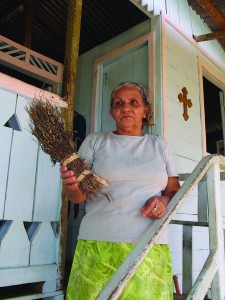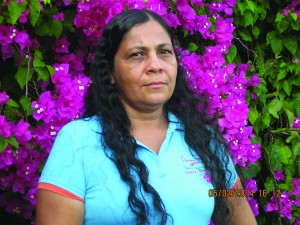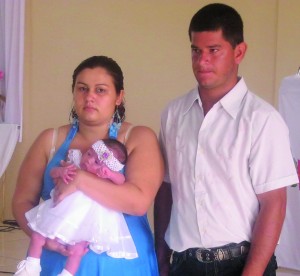The Hard Life of Women in Rural Costa Rica: Super Woman’s Daughter

By Jack Ewing
A few months back the story of Doña Porfiria Gomez, A Real Life Superwoman appeared on this site. This was the story of a campesina who was married as an adolescent of 14 years to a man of 23 and, shortly thereafter, left her family in Guanacaste. With all of their meager possessions on their backs, she and her new husband, Jose Artavia, traveled several hundred kilometers on foot, by boat, by bus, and catching the occasional ride to a remote place called San Miguel, about 30 kilometers south of Quepos. Furthermore they did this entire journey barefoot. Neither owned a pair of shoes. There they worked hard and forged a new life. The article tells how Doña Porfiria gave birth to 14 children, 9 of them at home, and most of those without the assistance of a midwife. It tells of the great hardships they endured, and the conditions under which they lived. Yet somehow they survived as did 11 of their children, which have, up until February 2014, given her 16 grandsons and 11 granddaughters, who in turn, have given her two great-granddaughters.
After having written and published this story in Quepolandia, one of my readers suggested that it would be interesting to hear how the next generation lived compared to their parents. I agreed and decided to interview Doña Porfiria’s oldest daughter and second oldest living child, Gerardina de los Angleles Artavia.

As the oldest daughter Gerardina spent much of her childhood helping her mother and caring for her younger siblings. As a young child the chores she remembers most vividly are carrying water uphill from the creek, 200 meters from the house, in pots and pans and gallon jugs and bathing the younger children. All bathing was also done in the creek, so that meant walking the children down there, bathing them, and walking everyone back to the house while trying to keep them reasonably clean.
Their home was a one room thatch roofed house called a “rancho.” The walls were made with the stalks of a tough cane called “caña brava,” the floor was dirt, and the cooking was done on an open fire box called a “fogón.” This was where Gerardina was born and lived during her early years. As the materials used in the construction of the rancho weren’t very durable, the structure was replaced every five to eight years. Each new rancho was a little better than the previous one.
At six years of age Gerardina started school in San Miguel. There was only one classroom and one teacher for all six grades. Being in school didn’t mean a relief from her chores. Rather it meant that she had to get up earlier in the morning and do her work before walking three kilometers to the school house. She had to be in school at 7:00 AM. In the afternoon she had to walk back, sometimes in pouring rain. Nevertheless she loved school, and didn’t mind the extra work.
When Gerardina was nine years old her mother became ill and was bed ridden for three months. Don José talked to the teacher, and Gerardina was given permission to miss school for the duration of her mother’s illness. She remembers this as the biggest challenge of her young life. Now, in addition to caring for her mother, she and her father shared all of her mother’s tasks as well as their own. She had never cooked or washed clothes, but she was forced to learn in the school of hard knocks. Fortunately Don José knew a little about cooking, and between the two of them they kept the family fed. The neighbors pitched in and helped as well, and she learned to cook all of the basics: rice, beans, platano, and yuca. With the help of a neighbor lady, she even learned how to grind corn and make tortillas. Once her mother recovered it took some time before she was able to do everything she had done before, and Gerardina still had to do much of the work. In the end she missed the entire school year and had to repeat fourth grade the following year.
I asked Gerardina about her own health as a child. She told me that she has never had anything more serious than the flu and never had to go to the hospital as a child. As their water came from an open stream, intestinal parasites were a constant problem, but her mother had a home remedy that worked quite well, and the local clinic gave them free treatment for these disorders. In rural Costa Rica personnel from the Ministry of Health visit every home once or twice yearly and make sure that children have all of their childhood vaccines. There is no cost to the families for this service. Though she was never seriously ill, Gerardina did fall down and break her collar bone one time. Her father said that it wasn’t necessary to go to the hospital for such a small thing. For about a month she kept her arm in a sling, which Don Jose fashioned for her, and the break healed nicely.
Doña Porfiria gave birth to six children at home while Gerardina was still living with her parents. Don José played the role of midwife and dealt with the actual birth. As the oldest daughter Gerardina helped, but only by bringing things to her father. During the birth of one of her younger siblings, she made the decision that all of her own children would be born in the hospital. She knew that the doctor had told Doña Porfiria that she shouldn’t be giving birth at home. Gerardina couldn’t tell her mother what to do, but she could take that good advice for herself, and she did.

In April of 1985 at 17 years of age Gerardina married 23-year-old Alexis Berrocal Granados. Alexis’ family had a cattle farm in San Miguel, and the young couple moved there to live. It was the first time she had lived in a house with a wooden floor. A year later their first child was born. When the first labor pains began she climbed on a horse and rode two hours in drizzling rain to a place called Lagunas where a friend with a car took her to the hospital in San Isidro. All four of her children were born in San Isidro. All four children graduated from the grade school in San Miguel, but none went on to attend the high school in Matapalo. At forty five years of age Doña Gerardina is proud of her four children, all born in the hospital, and all still living. Additionally she has two grandchildren.
Over the years several factors combined to cause a decline in the profitability of cattle ranching, and Don Alexis’ family farm reached the point where it wouldn’t produce enough income to maintain the family. In 2007 the Berrocals moved to Hatillo in hopes that some of the family members could find work in the area. Sandra, the youngest daughter, found work at Hacienda Baru Lodge, and later Ana María, the oldest daughter as well. At first the salaries of the two girls were providing most of the income for the family. Later Don Alexis and the boys found work as well. The family members soon gained reputations as hard working and honest employees, and none have lacked for work since 2010. Today the family lives in a two-story house provided for them by Don Alexis’ employer. He is foreman of a large farm, and his two sons work with him. Ana María still works at Hacienda Barú, and Sandra has married and recently gave birth to a baby girl.
Like her mother Doña Porfiria, Gerardina’s pride and joy is her family. At times she wishes she could have known her own grandparents, but she accepts that life doesn’t always deal us all the cards we would like to hold.

